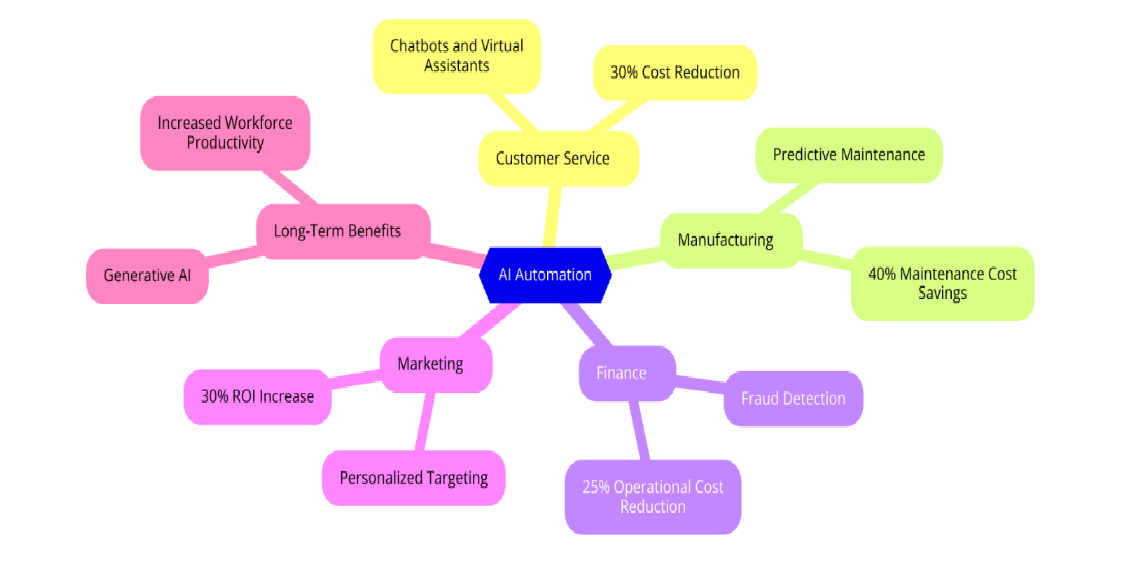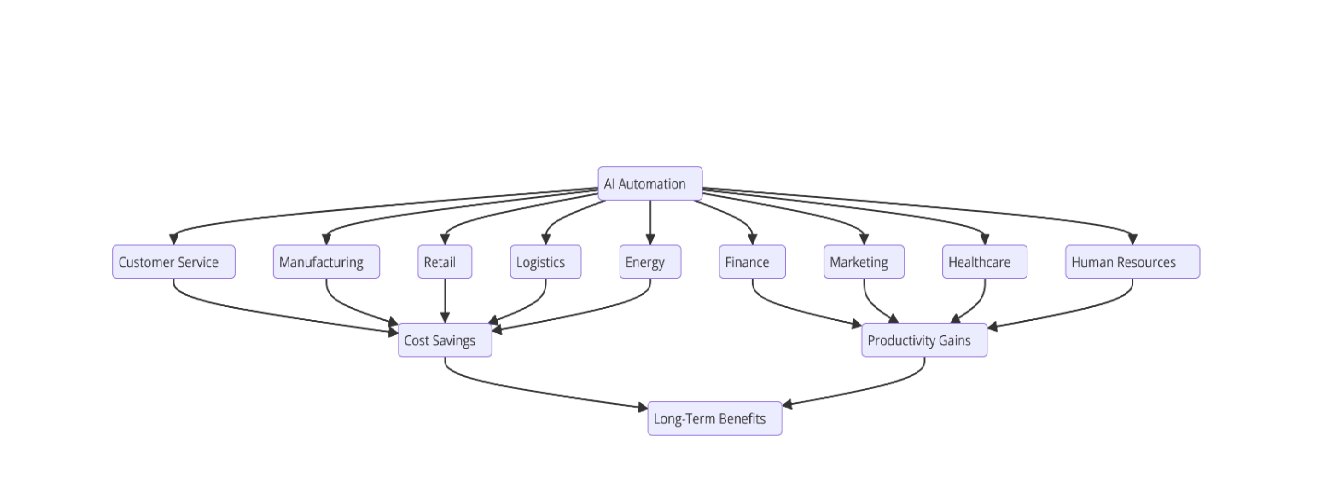AI automation has quickly become a transformative force across various industries, significantly lowering operational costs and improving efficiency. From customer service to manufacturing, finance, and marketing, AI automation helps businesses streamline repetitive tasks, allowing human resources to focus on more strategic and valuable work. This blog explores the cost-saving potential of AI automation, highlighting key statistics and insights from 2023 and 2024.

Table Of Contents
Key Areas of Cost Savings with AI Automation
1. Customer Service Automation
AI-powered chatbots and virtual assistants have revolutionized customer service by automating responses to routine inquiries. These tools reduce response times and the need for human agents, saving companies substantial labor costs.
- IBM estimates that businesses using AI-driven chatbots cut customer service costs by up to 30%, with bots handling up to 80% of standard inquiries.
- McKinsey reports that AI automation has improved productivity in customer service operations by 5-15%, with additional cost savings evident in marketing and sales .
2.Manufacturing and Supply Chain Automation
AI helps manufacturers optimize production and reduce downtime through predictive maintenance and supply chain automation, which results in substantial cost reductions.
- Deloitte found that AI-enabled predictive maintenance can cut maintenance costs byup to 40%and reduce equipment downtime by 50% .
- Bain & Company noted that automation leaders in manufacturing achieve 22%savings in operational costs due to AI integration .
3.Financial Process Automation
AI is reshaping the finance industry by automating fraud detection, loan processing, and back-office tasks. Robotic process automation (RPA) and machine learning are helping banks streamline operations, leading to faster processes and fewer errors.
- Accenture reports that financial institutions using AI can reduce operational costs by up to 25%, while speeding up processing times and improving accuracy in compliance
- Bain & Companyhighlights that early adopters of financial automation are seeing cost savings as high as 37%, while those slow to adopt only achieve 8% savings .
4.Marketing and Sales Automation
AI tools are automating marketing efforts such as email campaigns, ad spend optimization, and customer personalization, leading to higher ROI and reduced operational costs.
- Forrester predicts that businesses deploying AI in marketing automation will see a 30% increase in ROI, driven by more personalized targeting and efficient use of resources.
- Salesforce reports that 78% of companies using AI-driven marketing tools experience significant productivity gains and better customer engagement .
Long-Term Cost Savings with AI Automation
1.Workforce Productivity
AI frees up human employees by automating repetitive, time-consuming tasks, allowing them to focus on higher-value work. Businesses implementing AI automation consistently report significant boosts in productivity.
- McKinsey highlighted that companies leveraging AI see 5-15% increases in productivity, especially in operational and service-oriented sectors .
2.Generative AI and Advanced Automation
Generative AI, the next step in automation, is expected to drive even more savings. Bain & Company found that companies investing in generative AI experience faster deployment and higher ROI compared to those relying on traditional automation approaches . Leaders adopting generative AI are projected to save even more in operational costs, particularly in areas such as sales, human resources, and customer support.

Conclusion: Why AI Automation is the Future
AI automation is quickly transitioning from being a competitive advantage to becoming a necessity for businesses aiming to thrive in a fast-paced market. Across industries, companies that embrace AI automation are reaping significant cost savings, improved efficiency, and enhanced productivity. As these technologies continue to evolve, the benefits and cost reductions will only grow, solidifying AI automation as a critical investment for the future.
By 2025, AI automation is expected to contribute $15.7 trillion to the global economy, delivering major gains in productivity and reducing operational costs . Now is the time for businesses to scale their AI initiatives and unlock the full potential of automation.
References
- IBM. “AI Automation in Customer Support: Cost Savings and Efficiency.” 2023.
- Deloitte.“The Impact of AI Automation on Manufacturing Costs.” 2023.
- Accenture. “AI in Financial Services: The Path to Operational Efficiency.” 2023.
- Bain & Company. “Automation Scorecard 2024: Lessons Learned Can Inform Deployment of Generative AI.” 2024.
- McKinsey & Company. “The State of AI in 2024: Generative AI’s Impact Across Industries.” 2024.
These sources underscore how AI automation is driving cost savings and productivity gains, helping businesses across industries streamline operations and improve long-term profitability.

ABOUT AUTHOR
Venkateshkumar S
Full-stack Developer
“Started his professional career from an AI Startup, Venkatesh has vast experience in Artificial Intelligence and Full Stack Development. He loves to explore the innovation ecosystem and present technological advancements in simple words to his readers. Venkatesh is based in Madurai.”
